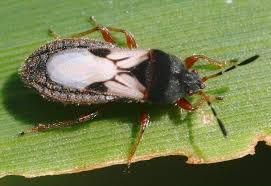
Chinch Bug



Ultralawn Incorporated
1055 East 260th Street
Euclid, OH 44132
216.731.7756
440.951.3738
Office hours Monday-Friday 9-3 call today with any questions

Description: Chinch bugs have piercing-sucking mouth parts and they feed on the sap of grass plants. They
reside in the thatch area of the turf grass stand and prefer to feed on the
lower leaf sheath and crown area of the plant. The chinch bug can be a
major insect pest on home lawns throughout the country. The hairy
chinch bug is the most common species in the Northeast. The hairy
chinch bug prefers bent grasses, but will attack many other lawn grasses
as well. The adult chinch bugs are about 3 to 5 mm (1/8 to 1/5 inch) in
length and black with white markings on the wings. The wings rest flat
over the back of the insect, and there is a black spot between the wings.
Adults may be long-winged or short-winged. There are five growth cycles
of chinch bugs ranging in size from 1 to 3 mm (1/32 to 1/8 inch). The first
two are red, with a white band across their abdomen, while the third and
fourth are orange with wing pads just beginning to appear. The fifth is
black with wing pads easily visible.
Damage: The chinch bug inserts its straw-like mouth-parts into the plant tissue and sucks out the plant juices
while injecting chemicals into the plant, which clog the vascular system. The area around the feeding puncture
usually turns yellow. Damaged areas first appear as small, irregular patches, which enlarge as the insects
spread. Chinch bugs are most damaging in open, sunny areas.
Life Cycle: Chinch bugs spend the winter as adults in partially protected areas (under shrubs or around
foundations of houses). As the weather warms in the spring, adults move into open areas, where females begin
laying eggs. Fifteen to 20 eggs per day are deposited for
two to three weeks. The eggs hatch in one to two
weeks, and the nymphs begin to suck the juices from
host plants. It takes 30-90 days to reach adulthood.
There are two generations per year, with a partial third
generation in unusually warm summers. There is
considerable overlap of generations, and all stages can
be found during the summer.
Detection: Examine the grass in the marginal areas of
injured patches, not in the clearly dead grass. Spread
the grass gently with your fingers and look in the
thatch, near the soil surface. Chinch bugs are usually
very active in the summer, so you will be able to see
them scurrying around, especially on warm summer days.
Control: In many instances, chemical control of chinch bugs is necessary. However, studies have demonstrated
that lawns that receive adequate amounts of water throughout the summer (preferably weekly deep watering)
are able to tolerate relatively high populations of chinch bugs without sustaining damage. Plant resistance has
also been reported for a number of turf grass species and cultivars. Turf grass managers usually control chinch
bug populations after major damage has occurred. To avoid this problem in areas with habitual problems, an
April to mid-May insecticide application will control the over wintering females and subsequent generations
during the summer. Another infestation may occur from adjacent areas, but this process is slow and may
require an additional year or more. This adult treatment must be made before egg laying occurs. Avoid mowing
the area for two or three days afterward.


July Chinch bug damage
Adult Chinch bug feeding


















